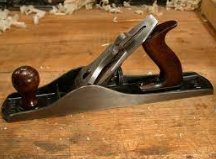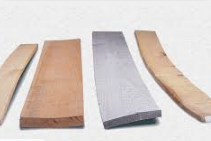Beautiful on the inside (or other side)
Maker Works Ann Arbor to the (project) rescue again!
My 60+ year old oak fence boards, the weathered side and the jointered side (read more for what that means)
I wanted to see what my 60 year old oak fence boards look like underneath the weathering. , since I’d like to find contractors who would use this beautiful wood in their carpentry projects.
(As my 60 year old fence boards came down (usually they rot out where the nails join the board to the fence post), I brought them into the barn to store them where it’s dry and they won’t rot. I have stalls and stalls filled with boards, some as long as 14 feet, most 8-12 feet long. And of course lots of shorter ones that broke somewhere in the middle when a horse leaned on them. Mostly 2”x6” boards, and full dimension (other than 60 years of weathering shrinkage), not the dimensional lumber they cut today (where a 2x4 is actually only 1 1/2” x 3 1/2”)).
When I asked at Maker Works Ann Arbor how to do “smooth off and clean up” a few of my boards to see what they look like underneath, they told me to take the “Planer-Jointer-Sander” class, so I signed up.
I didn't know what a planer/jointer was.
I sort of knew what “planer” meant (there’s a hand tool by that name that levels wood off, my dad used to have one in his shop).
Planer hand tool
And I knew what a sander was. Jointer? Oh well, they’ll tell me what it is.
If you are like me and have never heard of a “jointer”, it’s a tool that makes a board completely level on one side. It takes out any bowing (unlevel from one end of the board to the other), cups (unlevel from one side of the board to the other), and twists.
Since I just wanted to smooth off the back surface of the boards, it turned out that the Jointer, (the machine I was least familiar with before taking the class) was the tool for the job
(I now know much more about how various kinds of unlevel boards are described, and so will you after looking at the pictures below)
(And I have boards that would make the middle board on the left-most picture look perfectly flat, straight, and level. 60 years of weathering as a fence board can do that.)
The planer gives you a cut perfectly parallel to the bottom surface of the board.
So if you plane a bowed, cupped, twisted board, you wind up with a bowed, cupped, twisted board that’s the same thickness from one crooked end to the other (probably not what you want).
if instead you “jointer” the board to get one surface level, then plane it, and you wind up with a flat board that’s both perfectly flat and also the same width all the way from end to end and side to side.
As this 15 minute jointer video explains (which I watched after the class), it’s important to have flat boards the same width if you are doing something like paneling or gluing the boards together for some reason.
Took the class. Used the SOP a few days later to take on the project.
SOP stands for Standard Operating Procedure, a “Lean”/Toyota Production System term for a written document setting out the specific steps for doing something, in this case operating the tool.
All of the tools at Maker Works Ann Arbor have a notebook with the SOP for that machine/tool next to it, and after a checkout class for some more complicated tools, the SOPs are how anyone can safely and effectively use the tool.
One of the founders of Maker Works Ann Arbor worked at Toyota before starting Zingerman’s Mail Order (ZMO). Zingerman’s Mail Order (ZMO) is where you can order wonderful Zingerman’s food mailed to you after you leave Ann Arbor (or if you’ve never been to Ann Arbor but want the great food).
ZMO runs on “Lean” principles, which were then brought into Maker Works.
Lean and Continuous Improvement (another Toyota principle) have enabled ZMO to increase the number of boxes it can ship in a day while reducing its cost per box.. ZMO now teaches a Lean Kata class, and University of Michigan Ross School of Business students tour regularly.
Beautiful on the inside (or other side). The inside of the boards turned out to be absolutely beautiful (to my untrained but appreciative of nature eye). A lot of difference from one board to the other in terms of color and texture, to be expected.
Morel mushrooms
“There's a morel here“ as my mentor used to say (as in morel mushrooms, a delicacy that can be found growing wild in our Michigan woods) (pun intended).
Zingerman’s Roadhouse, Morels in Pasta (Seasonal)
Til next time…








